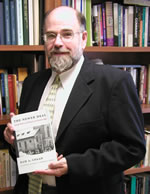 David O’Reilly’s Philadelphia Inquirer article, A Study Asks: What’s a Church’s Economic Worth?, explores the findings of a recent study investigating the economic worth of select local congregations in Philadelphia. The research was conducted last summer by Partners for Sacred Places and Ram Cnaan, professor of social welfare at the University of Pennsylvania. In additional to chairing the doctoral program in social welfare, Cnaan (pictured at right) serves as the Associate Dean for Research and as the Director of the Program for Religion and Social Policy Research.
David O’Reilly’s Philadelphia Inquirer article, A Study Asks: What’s a Church’s Economic Worth?, explores the findings of a recent study investigating the economic worth of select local congregations in Philadelphia. The research was conducted last summer by Partners for Sacred Places and Ram Cnaan, professor of social welfare at the University of Pennsylvania. In additional to chairing the doctoral program in social welfare, Cnaan (pictured at right) serves as the Associate Dean for Research and as the Director of the Program for Religion and Social Policy Research.
The research team:
devised of 54 value categories, they attempted to calculate the economic “halo effect” of a dozen religious congregations in Philadelphia – 10 Protestant churches, a Catholic parish, and a synagogue.
They added up the money generated by weddings and funerals, festivals, counseling programs, preschools, elder care. They tallied the salaries of staff and the wages of roofers, plumbers, even snow shovelers. They put dollar signs on intangibles, too, such as helping people find work and teaching children to be socially responsible.
The annual economic benefit of the twelve congregations studied to the community was determined to be $50,577,098, which included a range of -$225,995 to +$22,440,382. Interestingly eleven of the twelve faith communities had a positive net worth, with the lowest being computed as +$750,244.
So What?
The research blended established values (such as “$19,600 for pastoral counseling that prevents a suicide”) with values established by Cnaan (such as “$375 on “teaching pro-social values” to a young child”). While the study has not yet been published, it will provide local congregations a formula to “produce hard numbers to show community organizations, policy makers and potential funders the value of its local presence.”
- Are you surprised that the annual economic benefit of the twelve congregations studied exceeds $50 million? Why or why not?
- Would your congregation consider using this or another formula to estimate its annual benefit to your community? If your congregation possessed that data (regardless of whether it was established by an independent team of researchers or a leadership team within your congregation) how would it be utilized?
- Without any mention of economics, explain your understanding of how your local congregation contributes to the well being of the larger community.